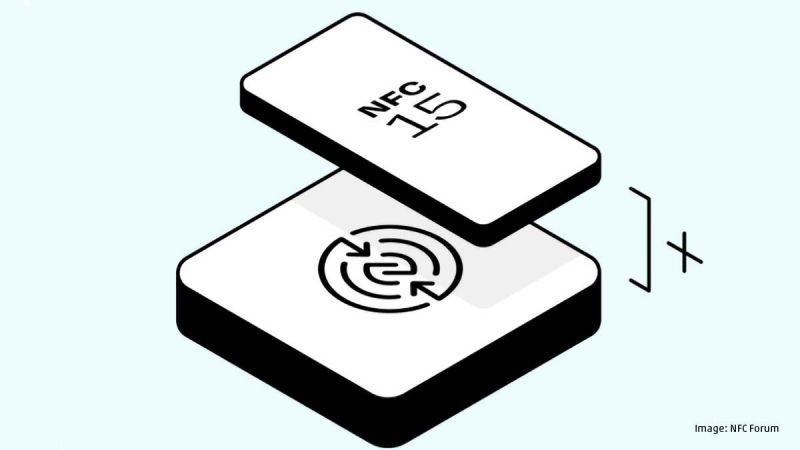- News
- What is NFC Forum Release 15 ?
What is NFC Forum Release 15 ?

The NFC Forum has just unveiled its next major specification update: Release 15. This is not a cosmetic tweak - it represents a measurable shift in what NFC means, expanding the practical envelope of contactless interaction, extending use-cases and signalling how NFC is evolving from payments and tags into a broader connectivity platform.
Why Release 15 matters
Until now, NFC has meant "very close, very quick". Hold your device within a few millimetres of a reader or tag, align it precisely and you're done. With Release 15, the aim is to substantially increase the scan distances (or 'operating volume' in tech speak) by a factor of 4. What this means :
- The baseline range moves from roughly 0.5 cm to up to 2 cm
- That means less specific alignment, fewer failed taps and potentially faster interactions
- Aligning mobile phones, wearables, rings, keycards, etc., becomes simpler. This is particularly the case for devices with smaller antenna designs.
- The specification emphasises that while the range increases, the fundamental characteristic of NFC - that the user makes a specific interaction or 'user intent' - remains central
- Release 15 also embeds support for broader ecosystem challenges, notably the Digital Product Passport (DPP) requirement and sustainability-driven product lifecycle tracking
In short: NFC is being upgraded to be more forgiving in terms of physical alignment, more expansive in its reach and more versatile in its use-cases.
What's new and improved
Here are the key elements of Release 15:
Extended Range / Operating Volume
The headline feature. The NFC Forum states certified devices under Release 15 must support an operating range up to 2 cm (versus ~0.5 cm historically). This enables connections to begin sooner and last longer, with less fine-tuning of position.
Faster, More Reliable Contactless Interactions
Because the device doesn't need to be pressed so tightly or aligned so precisely, the system is more robust. Failures reduce; user frustration shrinks.
New Use-Cases Become Practical
The extended range opens doors (literally) for devices in smaller form factors (rings, wearables), and for new roles (e.g., a mobile phone acting as a payment terminal). Other sectors flagged include automotive access, transit, smart homes/appliances, wireless charging (up to 1 W negotiation), all enabled via the improved baseline.
Support for Digital Product Passport / Circular Economy
Release 15 explicitly references support for DPP enabling an NFC tag to act as a lifecycle identifier for a product (embedded sustainability data, traceability, reuse) via NDEF (NFC Data Exchange Format) records. This aligns NFC not just with convenience and payments, but with ecological responsibility and regulatory-driven product transparency.
Maintaining Security & User Control
Despite the increased range, the NFC Forum emphasises NFC still requires proximity, user intent (a tap or movement), and proper confirmation.
Certification and Specification Release
Release 15 is comprised of Specification Release 15 (the standards themselves) and Certification Release 15 (the compliance program).
The changes
The NFC Forum developed this change in the context of shifting demands:
- The miniaturisation of devices: Wearables, smart rings, IoT sensors all have less room for large antennas and require more forgiving protocols.
- The rise of "tap" beyond payment: Access, identity, product interaction (IoT, appliances), where users expect seamless taps, not fiddling.
- Sustainability and product-lifecycle visibility becoming increasingly important, hence DPP.
- Competitive pressure: NFC faces competition from BLE / UWB / other proximity solutions, so raising the baseline helps maintain relevance.
- The recognition that small usability frictions (mis-aligned taps, failed connections) become big barriers to mass adoption.
In other words: NFC is evolving and improving. Without question, one of the main concerns raised with NFC is 'scanability'. Release 15 moves the game on and tackles this issue head on.
Limitations
- Although the increased range target of 2cm is substantial, it's clearly still less than Bluetooth or UWB. In essence, NFC isn't trying to move into a new space - it's trying to make sure the current space is as good as it can be.
- This is likely to only apply to new devices. Many existing devices are not likely to be able to upgrade which means that these improvements aren't going to be seen overnight.
- While specifications are now available, public certification begins in Autumn/Fall 2025. Therefore, the first seeds of consumer-level impact aren't likely to be seen until later in 2026.
- Implementation difficulties - it's not easy to impliment these changes in small form-factor devices. It's possible this will impact costs and/or designs.
In summary
Release 15 from the NFC Forum is both significant and subtle. On the face of it, extending the range from 0.5 cm to 2 cm doesn't sound earth-shattering but in practice, it removes a key friction point from many NFC interactions. It opens up more consistent, reliable taps in devices where alignment was always tricky (wearables, rings, small IoT) and expands the palette of what a "tap" can trigger: payments, access, product data, wireless power, even mobile-phone-as-terminal.
At the same time, by embedding support for the Digital Product Passport and circular-economy use-cases, it expands NFC's role from transactional to lifecycle-data carrier. In a marketplace increasingly focused on sustainability, circularity, traceability, that is a strategic move.
It won't all be immediate. The certification programme begins later in 2025 and the majority of devices will likely show up in 2026. But the direction is clear: NFC is advancing. And for those of us who've grown used to tapping phones, cards or rings — the next generation won't just feel the same. It'll feel better.

A quick intro to NFC tags - what they are, how they are used and the different types of tags

Pricing for our encoding, scanning, ID printing and batching services.

Details of our NFC tag encoding services.

How to order ID / QR code printing on your NFC tags.

How you can order a UID scan of your NFC tags.







